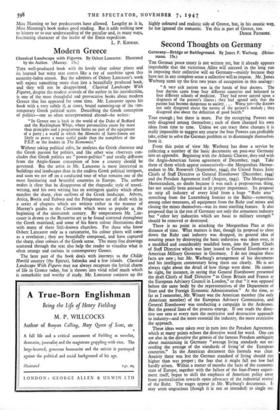Modern Greece
Tins well-produced book with its lovely clear colour plates and its learned but witty text comes like a ray of sunshine upon this austerity-laden season. But the admirers of Osbert Lancaster's work will expect something more than just a beautifully produced book, and they will not be disappointed. Classical Landscape With Figures, despite the modest avowals of the author in his introduction, is one of the most thoughtful and provocative books about modern Greece that has appeared for some time. Mr. Lancaster opens his book with a very subtle if, at times, brutal summing-up of the -7.on- temporary Greek political scene. Describing the Greek conception of politics—one so often misrepresented abroad—he writes: " In Greece one is back in the world of the Duke of Bedford and the Rockingham Whigs, where personalities count for more
than principles and a programme forms no part of the equipment
of a party ; a world in which the Memoirs of Saint-Simon are
likely to prove a more useful guide than the pamphlets of the P.E.P. or the leaders in The Economist."
Without taking political sides, he analyses the Greek character and the Greek passion for politics, and like other wise observers con- cludes that Greek politics are " power-politics " .and totally different from the Anglo-Saxon conception of how a country should be governed. But the artist in Mr. Lancaster is more interested in buildings and landscapes than in the endless Greek political intrigues, and soon we are off on a conducted tour of what remains one of the most fascinating and beautiful countries in Europe. The author makes it clear that he disapproves of the rhapsodic style of travel- writing, and his own writing has an astringent quality which often matches the sharp, clear outlines of the Greek landscape. Athens, Attica, Boetia and Euboea and the Peloponnese are all dealt with in a series of chapters which are written rather in the manner of Murray's guides to the Continent which were so popular at the beginning of the nineteenth century. By temperament Mr. Lan- caster is drawn to the Byzantine art to be found scattered throughout the Greek mainland; and some of his finest colour illustrations deal with many of these little-known churches. For those who know Osbert Lancaster only as a caricaturist, his colour plates will come as a revelation ; they are beautifully composed, and have captured the sharp, clear colours of the Greek scene. The many line drawings scattered through the text also help the reader to visualise what is often strange and curious in contemporary Greece.
The later part of the book deals with journeys to the Childe Harold country (the Epirus), Salonika and a few islands. Classical Landscape With Figures may not always recapture the lyrical charm of life in Greece today, but it throws into vivid relief much which is remarkable and worthy of study. Mr. Lancaster conjures up the
highly coloured and realistic side of Greece, but, in his caustic way, he has ignored the romantic. Yet this is part of Greece, too.
DEREK PAT1VIORE.


































 Previous page
Previous page